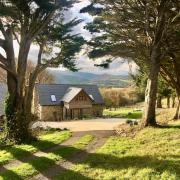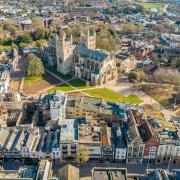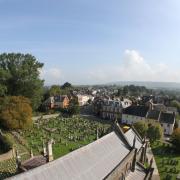Dartmoor is one of the best places in the UK to spot stars. HAZEL SILLVER joined astronomers Rob and Bryony Tilsley on the moor on a starry night

Through the telescope, the star Procyon shivers with amber and pink light and it is hard to comprehend its size and distance. Although it seems a small hovering diamond, it is in fact a vast mass of fire some 11 light years away.
“I love astronomy because it challenges my brain,” says astronomer Rob Tilsley of Dartmoor Skies, a charity that runs stargazing events on Dartmoor.

“It is mind-boggling to try to conceive how big, how old and how far away the planets and the stars are. Some stars are so big, they rival our own - the sun - in size, and others are so enormous they dwarf the sun in size!”
I’m standing on the edge of Dartmoor, peering through Rob’s eight-inch telescope at the constellations that are visible, including the Little Bear (Ursa Minor) and the twins, (Gemini).

Astronomy has been a lifelong hobby for Rob, kickstarted by watching a meteor shower whilst camping with his father as a child. After meeting his wife Bryony at Dartington College of Arts, she gave him a telescope as a birthday gift, which fuelled his passion even more and ignited her own love of astronomy.
“It was Jupiter that did it,” she recalls. “Rob put the planet into the telescope and I could see its bands and the Galilean moons around it. I was enthralled to find it moving out of view because I - being on the rotating Earth - was moving! After that, I was hooked.

“We started showing the stars to friends and family and enjoyed it so much that we decided to start organising events for the public.”
The result is Dartmoor Skies, which offers star observation nights on Dartmoor and in the surrounding area. People of all ages and astronomy experience are welcome to attend and enjoy Bryony and Rob’s wealth of knowledge and enthusiasm for the night sky.

They offer a range of telescopes to try, including astronomy binoculars and a small telescope for young children.
“Showing people stars is a great feeling,” says Rob. “We love providing a fun, relaxed experience to spark their interest and offer a place to begin learning because space is so big that people often don’t know where to start. Eventually we hope to take the leap to doing this full time. We’d like to do more work with schools and set up a mobile observatory.”

Based in Buckfastleigh, the couple don’t have far to go to enjoy some of best starscapes in the country. Dartmoor’s size and scant artificial light make it a stargazer’s paradise.
Indeed the national park is currently bidding to receive official status as a Dark Sky Park - a badge of honour, which would attract astronomy enthusiasts and award it protection from artificial light pollution.

“If you want a stargazing adventure up on the moor, the darkest place to head to is the north-west quadrant,” advises Bryony. “However, the best spot to look at stars is the place you’re most likely to do it. In our case, it’s 200m up the road, where there aren’t any street lights.”
There are different things to look out for in each season. Spring is known as ‘galaxy season’ because the Virgo Supercluster is visible, allowing us to see thousands of galaxies with an amateur telescope.

And in summer, we’re treated to the Milky Way and the Perseids meteor shower, which can be seen every few minutes during the second week of August when the meteors reach their peak.
Rob and Bryony therefore host a variety of events throughout the year, each themed to what is happening in the night sky at that time.
As I gaze up into the stratosphere in mid-January, I am lucky to be zooming in on a full moon. In the telescope, it is silvery bright and clear. Rob points out the Tycho crater left by a meteor 180 million years ago, as well as the Sea of Tranquility where Neil Armstrong took his first steps.
It is all rather humbling.
“Astronomy does fill you with awe,” says Rob. “Trying to comprehend the ages and distances involved is what gets you hooked.”
A decent telescope is just over £100. I might start dropping birthday hints…
To find out about events being held by Dartmoor Skies this spring, go to dartmoorskies.org
What to see in the spring night sky
Lyrid Meteor Shower - Active from 16 to 25 April, the Lyrids will peak on 22 and 23 April with around 20 meteors per hour.
The Leo constellation - April is a great time to see Leo the lion. The stars Dubhe and Merak in Ursa Major point down to the constellation. Look out for a backwards question mark. This is an asterism known as the Sickle and forms the head of the lion. If you have a telescope you can take a look at the Leo triplet, a trio of spiral galaxies which sits near the lion’s back leg between the stars Chertan and Iota Leonis.
Alignment - Late evening on 6 and 7 May, a thin crescent moon will sit in alignment with Mars, Aldebaran and Betelgeuse.
Catching the sun
Whilst even glancing at the sun without any eye protection can damage our eyes, it is possible to stare at it with a solar telescope. Using this fascinating bit of kit, Bryony and Rob sometimes hold sun gazing events during daylight hours.
“The solar telescope allows us to view a thin slither of the sun’s light spectrum, which makes it look orange,” explains Rob.
“And the sun spots within it - which are associated with solar flares and eruptions and can be many times larger than the Earth - appear black. It’s an incredible sight to behold.”



























